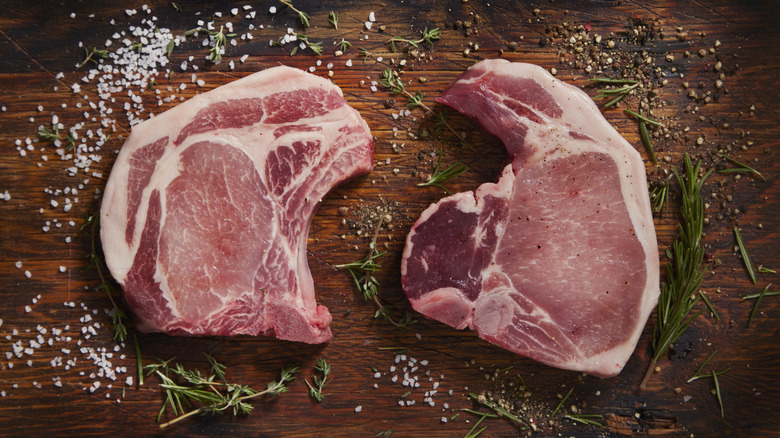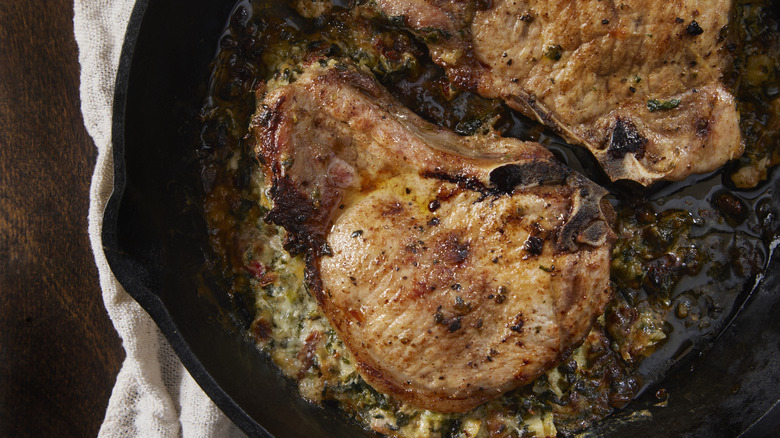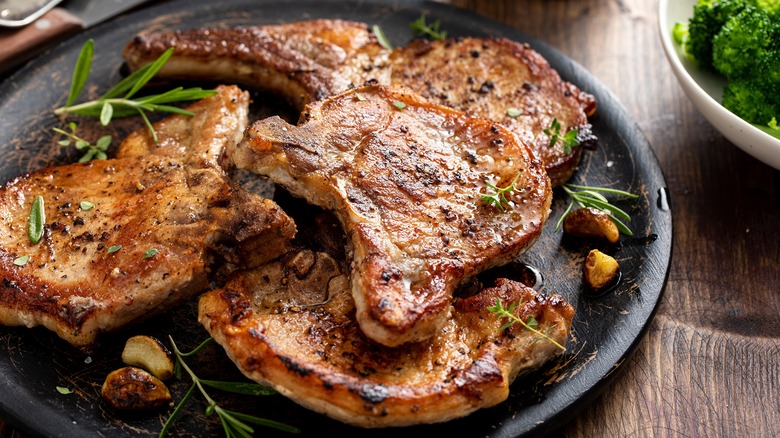Well-Done Pork Chops Are The Relic Of A Frightening Past
A tough pork chop is an unfortunate reality of many family dinners. How many hours have we wasted sawing through tough, gray hunks of pork chops, thinking that there was no other way to serve the protein? After all, pork, so we are told, is riddled with potentially deadly pathogens such as trichinella which make undercooking pork a dangerous endeavor. For this reason, many home cooks find cooking pork to be intimidating, as undercooking pork products can result in a scary and potentially deadly illness. And, like chicken, pork is often viewed as a meat that requires a well-done cooking level.
For years, it was recommended that pork be cooked to 160 degrees Fahrenheit to prevent trichinellosis or trichinosis. Trichinellosis, which is caused by the parasitic worm trichinella, is most often associated with eating raw or undercooked pork products, however, other animals, including wild game, also carry the parasite.
Trichinella has existed, and infected human hosts, for thousands of years, with evidence of the parasite being found in Egyptian mummies. It can cause severe illness and even death. Because of the severity of trichinosis, many home cooks have either avoided cooking pork altogether or overcooked the meat to a well-done state to avoid infection. However, such precautions are no longer necessary, thanks to innovations in commercial pork production.
The dangers of trichinella
Because of improvements in pork production, the New York Department of Health explains that trichinella is no longer found in pork raised indoors on commercial farms in the United States – though it still infects wild game and can spread to pigs raised outdoors in proximity to wild boars and rodents. Still, this means trichinellosis has all but been eradicated in the United States since the 1990s, according to The Centers for Disease Control and Prevention. Each year, only about 16 cases of trichinellosis occur in the United States, most of which are the result of consuming wild game meat, particularly wild boars and even bears.
Overall, the risk of consuming pork tainted with trichinella from commercially raised products is very low, and as a result, the USDA changed its cooking recommendation for commercially farmed pork in 2011. It is now recommended that consumers only need to cook their pork to 143 degrees Fahrenheit.
Doing so might feel, well, iffy, especially to those who practice stringent food safety practices, however, you can rest assured that your grocery store-bought pork chop is free from trichinella and that cooking to a lower temperature will produce a more tender pork chop without risking your health.
How to handle meat safely
But just because trichinellosis is no longer prevalent in the United States does not mean that you should forgo safety when cooking your pork chops. Pork products are still susceptible to pathogens such as E.coli, Salmonella, and Staphylococcus. So you should still take care while handling pork, making sure to thoroughly wash your hands after handling raw meat, and properly sanitize all utensils, surfaces, and containers that your raw meat has touched. Additionally, you should avoid touching your mouth or face until you have properly washed your hands after handling raw pork.
When it comes to storing your raw pork, you should keep your meat at a temperature below 40 degrees Fahrenheit to prevent meat spoilage. And you should never thaw your frozen meat at room temperature or in hot water. Instead, you should thaw your frozen meat in the refrigerator, so that it stays at a safe temperature throughout the thawing process. Making sure to abide by these basic safety guidelines will help you to avoid potentially dangerous pathogens.


